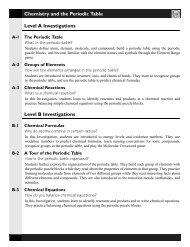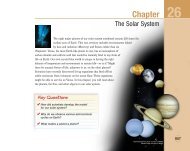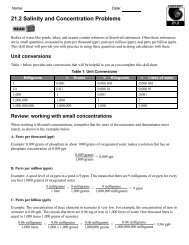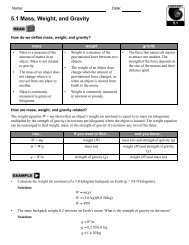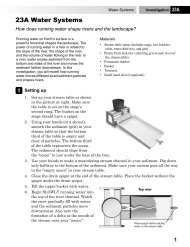Unit 3: Matter and Energy - CPO Science
Unit 3: Matter and Energy - CPO Science
Unit 3: Matter and Energy - CPO Science
You also want an ePaper? Increase the reach of your titles
YUMPU automatically turns print PDFs into web optimized ePapers that Google loves.
Specific HeatComparing Silver <strong>and</strong> Aluminum1 kilogramSilverSpecific heat: 235 J/kgºCHeavier atoms mean feweratoms per kilogramAluminumSpecific heat: 900 J/kgºCLighter atoms mean moreatoms per kilogram<strong>Energy</strong> is spreadover fewer atoms1 kilogram<strong>Energy</strong> is spreadover more atomsMore energy per atomLess energy per atomHigher temperaturegain per joule(lower specific heat)Lower temperaturegain per joule(higher specific heat)
Density(kg/m 3 or g/cm 3 )DensityD = m VMass (kg or g)Volume (m 3 or cm 3 )Steel cubeVolume: 1.0 cm 3Mass: 7.8 gDensity: 7.8 g/cm 3Steel DensityNailVolume: 1.6 cm 3Mass: 12.5 gDensity: 7.8 g/cm 3
2Stress (N/m )StressFσ =AForce (N)2Area (m )5N force5,000N force
BuoyancyLBSNLBSNLBSN0NLBSN2.25N.2.4.61231.8N.2.4.61231.72N.2.4.6123.2.4.6123.84.84.84.841.051.051.051.05WATERGLYCERINThe rockweighs 2.25Nin air.The rock weighs less in water <strong>and</strong>glycerin because these fluids exert anupward buoyant force on the rock.Therock weighs nothing in mercury. Why?MERCURYWhich liquid exerts the most buoyant force on the rock?
Charles’ LawInitial volume (m 3 )New volume (m 3 )V 1=V 2T 1 T 2Initial temperature (K)New temperature (K)Pressure <strong>and</strong> mass constantThe air inside a hot-air balloon is less dense than thesurrounding air.The hot air in the balloon takes up more volume thana similar amount of cooler air outside the balloon.
Pressure-Temperature RelationshipInitial pressure (N/m 2 )Initial temperature (K)P 1 P= 2T 1 T 2New pressureNew temperatureVolume <strong>and</strong> mass constantLow TemperatureHigh TemperatureSlowermoleculesFastermoleculesLowerpressureHigherpressureFaster molecules create higher pressure because they exert largerforces as they collide with the sides of the container holding them.
Three Subatomic ParticlesSubatomicpartialOccurrenceChargeMass (g)Relative MassElectronfound outside of nucleus-19.109 × 10 -281ProtonNeutronfound in all nucleifound in almost all nuclei(exception: most H nuclei)+101.673 × 101.675 × 10-24-241,8371,839Size <strong>and</strong> Structure of the AtomAtomDiameter =10 -10 mNucleusDiameter = 10 -15 m
1H1hydrogenLi3lithiumNa11sodiumK19potassiumRb37rubidiumCs55cesiumFr87franciumPeriodic Table of the Elements2Be4berylliumMg12magnesiumCa20calciumSr38strontiumBa56bariumRa88radiumLa57Ac893 4 5 6 7 8 9 10 11 12Sc Ti V Cr Mn Fe Co Ni Cu Zn21Y39Ce58Th9022Zr40Hf72Pr59Pa9123Nb41Ta73Li3lithium24Mo42W7425Tc43Re7526sc<strong>and</strong>ium titanium vanadium chromium manganese ironRu44yttrium zirconium niobium molybdenum technetium rutheniumOs76hafnium tantalum tungsten rhenium osmiumNd60U9227Rh45Ir7728Pd46Pt7829Ag47Au7930Cd48Hg8013 14 15 16 17B C N O F5Al13Ga31In49Tl816Si14Ge32Sn50Pb827P15As33cobalt nickel copper zinc gallium germanium arsenicSb51rhodium palladium silver cadmium indium tin antimonyBi83iridium platinum gold mercury thallium lead bismuth8S16Se34Te52PoPm Sm Eu Gd Tb Dy Ho Er Tm Yb Lu61 62 63 64 65 66 67 68 69 70 71849Cl17Br35I53At8518He2Ne10boron carbon nitrogen oxygen fluorine neonAr18aluminum silicon phosphorus silicon chlorine argonKr36selenium bromine kryptonXe54tellurium iodine xenonRn86polonium astatine radonRf Db Sg Bh Hs Mt Uun Uuu Uub Uuq Uuh Uuh104 105 106 107 108 109 110 111 112 113 114 115 116 117 118rutherfordium dubnium seaborgium bohrium hassium meitnerium ununnilium unununium ununbium ununquadium ununhexium ununoctiumlanthanum cerium praseodymium neodymium promethium samarium europium gadolinium terbium dysprosium holmium erbium thulium ytterbium lutetiumactinium thorium protactinium uraniumMain Group ElementsTransition ElementsROWS = PERIODSElement symbolAtomic numberElement nameNon metalsMetalsCOLUMNS = GROUPSNp Pu Am Cm Bk Cf Es Fm Md No Lr93 94 95 96 97 98 99 100 101 102 103neptunium plutonium americium curium berkelium californium einsteinium fermium mendelvium nobelium lawrenciumhelium
Electrons <strong>and</strong> <strong>Energy</strong> LevelsTotalIn the outermostenergy levelLi31Be42B53C64N75O86F97N1081st energy levelCarbon atom2nd is outermost energy levelOxygen6 valence electronsWater moleculeH 2 O8 valenceelectrons together4 valence electronsHydrogen1 valence electron
Quantum TheoryGround stateExcited stateGround state<strong>Energy</strong>absorbed<strong>Energy</strong>(light)released
Spectral Lines700 600 500 400R O Y G B VHydrogenSodiumHeliumNeonMercury



